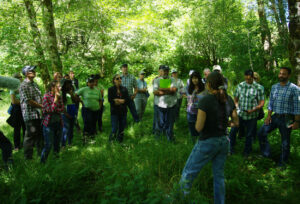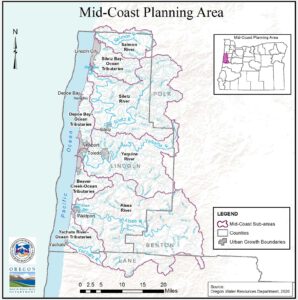The Mid-Coast region of Oregon is surprisingly complex in its hydrology. It contains eight hydrological basins, each with its own population demographics, water supply, and water needs. In this sense, the mid-coast is a microcosm of Oregon as a whole, which is also a climatically and geographically diverse state. In recognition of this fact, the state established an Integrated Water Resources Strategy in 2012 to coordinate efforts to understand and balance diverse water needs. The Mid-Coast Water Planning Partnership is one of four pilot programs to across the state working to create a local, place-based regional water plan using this voluntary, nonregulatory approach. In this interview, Alan Fujishin, a local farmer and a coconvener of the partnership, tells Municipal Water Leader about the partnership’s activities and accomplishments.
Municipal Water Leader: Please tell us about your background and how you came to be in your current position.
Alan Fujishin: My wife, Lorissa, and I manage Gibson Farms, a blueberry and cattle farm in the Siletz Valley of Oregon’s central coast. We were approached in 2016, at the beginning of this collaborative, place-based planning process, to help represent the agricultural community and rural interests in the Mid-Coast Water Planning Partnership. The partnership discovered that there is plenty of work to go around in water planning, so I agreed to become one of the coconveners along
with Seal Rock Water District, the City of Newport, and the Oregon Water Resources Department (WRD).

project on private forestland within the planning area.
Municipal Water Leader: Please tell us about the MidCoast Water Planning Partnership.
Alan Fujishin: It is a regional planning group that represents diverse water interests in the mid-coast region. We work to understand and meet the water needs of local communities, the environment, and the economy within a bounded area. Oregon is a diverse state when it comes to climate and geography, and our 20th-century experience led us to the conclusion that a one-size-fits-all water policy for the state doesn’t work very well. The state’s Integrated Water Resources Strategy attempts to remedy that by coordinating the activities of state agencies and establishing local, placebased discussions and programs around water that are tailored to local needs and priorities.
Municipal Water Leader: When was the partnership founded?
Alan Fujishin: The partnership had its first meeting in 2016, after the City of Newport and the Oregon WRD cooperated on a grant to get the process started. Since then, we have brought together more than 70 local partners to participate in the process. We are more than three-quarters of the way through our planning process, which, according to state guidelines, is a 5-step process. We wanted to involve local stakeholders early on to make sure that this was a collaborative process. Our second step was to really understand the natural and built water systems that we had here on the mid-coast, which are more complicated than you might imagine. Within this small area, there are eight major hydrologic basins and dozens of smaller ocean tributaries. Right now, we are working to identify current and future needs, including in-stream needs for fishing, aquatic life, habitat and recreation and out-of-stream needs for industrial, municipal, domestic, and agricultural uses. Then, over the next year and a half, we will pivot toward identifying, prioritizing, and carrying out practical solutions and strategies to meet those needs.
Municipal Water Leader: Was the partnership founded in response to a state policy?
Alan Fujishin: Yes. The Oregon Water Resources Commission adopted the Integrated Water Resources Strategy in 2012 in response to a directive from the legislature to meet Oregon’s current and future water needs. It established better coordination among the various agencies responsible for different aspects of water as well as the local communities they serve. This is important in a state like ours, where a high-desert area may get less than 8 inches of precipitation a year, but a coastal area may get over 100. Each region has its own needs.
In 2015 and 2016, the state established four pilot planning areas for place-based water planning, one of which was the mid-coast. The other pilot areas are basically defined by single hydrological basins within the drier eastern part of the state, rather than by a series of eight basins, as ours is. The midcoast is also the most diverse in terms of local demographics and water use. The state is looking at each of these pilot programs to learn how place-based planning works and to inform future water planning efforts around the state.
One of the benefits of a place-based planning approach is that it’s portable and scalable. The problems we have on the mid-coast of Oregon are different from the problems people have in a basin just over the Cascades. The flexibility of the model makes it valuable in helping solve Oregon’s water problems in a way that is tailored to each region.
Municipal Water Leader: Who are the members of the partnership? Are they primarily organizations or individuals?

Alan Fujishin: We wanted to maintain an open door for all potential partners to help inform the plan as well as help implement the plan once we have that in place. If folks support of our governing charter and want to participate as full partners, they can sign up at any one of our meetings. Some of our early partners were municipal and special water districts, local businesses and governments, state agency representatives, tribes, and local conservation groups. Since then, we’ve also attracted the interest of coastal residents who understand the value of water and want to contribute to a regional plan to help solve those issues. We have over 70 signed partners now, who run the gamut of water interests in the mid-coast. One of the benefits of the place-based planning approach is that a coastal resident who is just an interested member of the public has the same standing at the table as a large water provider. That levels the playing field and allows us to have meaningful discussions.
Municipal Water Leader: How is the partnership funded?
Alan Fujishin: The partnership has a range of funding sources. We receive some state funding through an Oregon WRD grant; we have also received grant funding from private nonprofits and organizations and from our local partners. We also receive significant in-kind funding from our local partners, including people’s time, effort, and talents.
Municipal Water Leader: How does the partnership plan to move from the research and planning stage to the implementation of its ideas?
Alan Fujishin: I think we’re doing a good job of identifying what the various needs are and projecting those needs into the future. We are aware that development and perhaps climate change are going to affect those needs, that Oregon may need more water in the future, and that our water supply may not be as robust as it has been in the past. Based on that understanding, we can then roll out ideas for how to address those issues together, regionally, and then prioritize those ideas. While those ideas may not be implemented by the partnership itself, our participating partners can work to secure the necessary resources and use the partnership’s plan to guide and validate their activities toward the benefit of the entire region, rather than working individually without mutual support.
Municipal Water Leader: How is the partnership helping accomplish things that individual agencies and people could not do on their own?
Alan Fujishin: One thing that became clear to me as an early participant in the partnership was that a lot of the water interests within our planning area have been working for decades in a siloed way. They weren’t necessarily talking with each other or sharing a lot of information. In some cases, they came down on different sides of a local issue and had a history of antagonism. In some ways, it was surprising to me that a nonregulatory, voluntary organization like the partnership has been able to create a space in which those previously siloed local government agencies, business entities, interested citizens, and nonprofits can come together and have a productive conversation in a nonconfrontational environment. That is going to be the basis of our shared success. This is not a forum like a public hearing in which one side comes out the victor and the other the loser. We’re able to look for win-win solutions and learn from each other. I’ve learned a lot through participating in this partnership, even though I’m a local resident who has been engaged in these issues in the past. Now we have a shared level of baseline knowledge about the region’s water needs and water availability. That will allow us to find practical and realistic solutions for the mid-coast region.
Municipal Water Leader: How does working collaboratively help the members of the partnership gain grant funding?
Alan Fujishin: Whenever we’re able to demonstrate to potential funders, be they public, private, or nonprofit, that although we are diverse constituents we agree through consensus that a project or effort is important in our local area, they are more likely to view it as a worthwhile investment of their time and resources. I think that will give us a real advantage as a partnership when it comes time to turn this plan into projects on the ground.
Municipal Water Leader: What is your message to the Oregon state legislature and to Congress?

Alan Fujishin: My message to the Oregon legislature and our state agencies is, first, one of gratitude. We’ve been working for more than 3 years now on this local planning process, and we have been given tremendous latitude to do so in a way that made sense considering local culture, local demographics, and local politics. The second message is that that work is not over yet. One of our main concerns as a partnership is that once we have this plan in hand, that plan not simply sit on the shelf. In order to avoid that, we will need to have the resources to implement the plan. I’m sure it will come as no surprise to those folks to hear that the plan will need continued support to go forward, but that’s the reality. I understand that with the biennial budget cycle, we can’t always make commitments many years ahead, but water requires a long-term view, and these place-based planning processes are a long-term effort. They’re not a oneand-done commitment.
Municipal Water Leader: What is your vision for the future?
Alan Fujishin: I would like people to be empowered to help solve important problems in their own communities. As we wrap up the plan, we want to continue to hear from constituents about their water priorities. Hearing from our partners about the ways they use and value water helps us learn from each other and develop shared ideas for ensuring water availability in the future. The sky’s the limit in terms of our ideas, and those ideas have already generated outside-the-box approaches and strategies. While our area is small, its water issues are surprisingly complex. We will need both creativity and cooperation to solve them.
Alan Fujishin is a coconvener of the Mid-Coast Water Planning Partnership. You can learn more about the partnership at www.midcoastwaterpartners.com.
